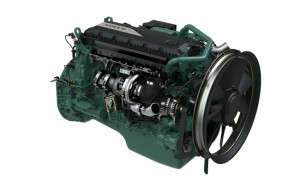Volvo Penta has lower TCO focus for Stage V engine range
First published in bauma Preview - March 12, 2019
 Volvo Penta’s Stage V engines, like the pictured D8, are said to offer optimum total cost of ownership
Volvo Penta’s Stage V engines, like the pictured D8, are said to offer optimum total cost of ownershipVolvo Penta’s new Stage V engine range for off-road applications is developed with original equipment manufacturers (OEMs) and end users in mind, delivering optimum productivity, uptime and total cost of ownership.
A major driver in the development of the new Volvo Penta Stage V range has been ensuring the engines and exhaust aftertreatment system work seamlessly together. Among other benefits, this maximises passive regeneration during normal operation and, therefore, removes the need for stand-still regeneration, boosting customers’ uptime, productivity and profitability.
In the D5 and D8 engines specifically, Volvo Penta has decreased cooling requirements by around 20%, meaning the size of the radiator can be reduced or power increased depending on customer need.
At the same time, Volvo Penta has succeeded in reducing fuel consumption (vs Stage IV) across the entire range to the benefit of end users’ bottom line and the environment.
“Field-testing of our new Stage V engines has proven extremely promising, boasting fuel consumption reductions of up to 5%,” says Giorgio Paris, head of the industrial business segment at Volvo Penta. “This means Volvo Penta can reduce CO2 footprint by around two fuel trucks per day – and considering the average life of our engines is 10,000-12,000 hours or more, the savings in fuel consumption alone will pay for the engine over its lifespan.”
Yet another positive contribution to customers’ operations is the oil change service interval, which has been lengthened from 500 hours to 1,000 hours.
When it comes to choosing the best solution, Volvo Penta says it is keen to help customers make the right choice. Its experts draw on their broad experience, supporting more than 300 customers in differing applications and segments – meeting a variety of demands and requirements according to application, installation and market.
Companies in this article
Volvo Penta
Product Launch Videos
Most popular news
- Fayat’s forward view – at bauma 2019
April 16, 2019 - Hitachi’s ZX65USB-6 mini excavator works harder with less fuel
April 15, 2019 - Komatsu boost fuel efficiency with its WA475-10 wheel loader
April 15, 2019 - Smiley Monroe launches conveyor belt page turner at bauma 2019
April 12, 2019 - Topcon’s sophisticated head-up display goes on show at bauma 2019
April 12, 2019 - Liebherr’s innovative piling rigs at bauma 2019
April 12, 2019











